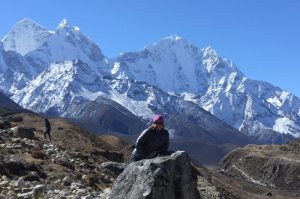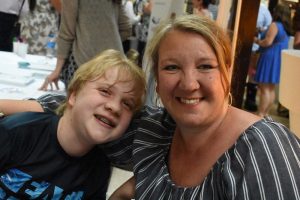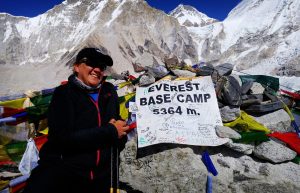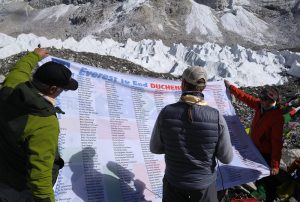November Ascent of Nepal’s Mt. Everest to Raise Money for Duchenne Research
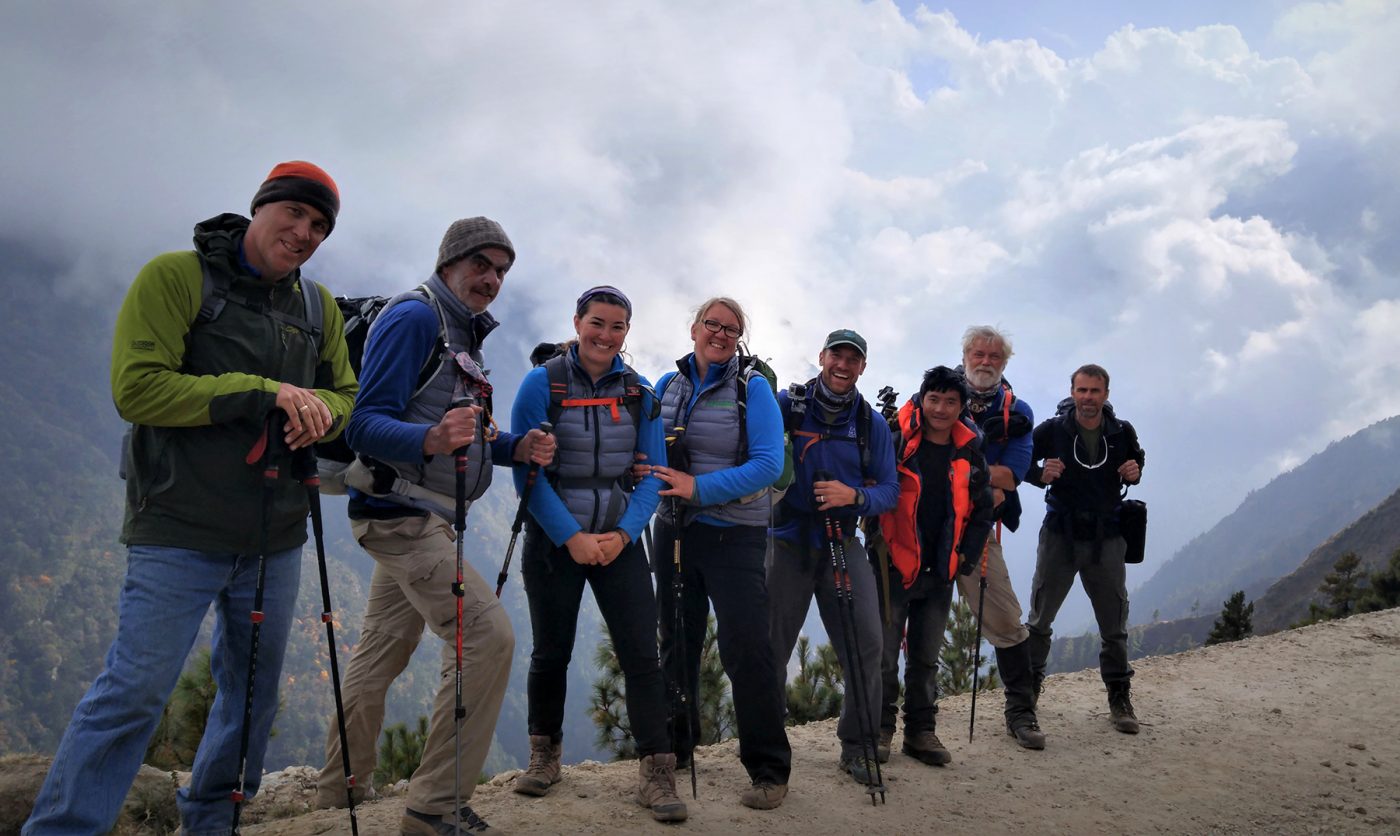
Trekkers raising money for Duchenne research pose for photos on the slopes of Nepal's Mt. Everest. (Photo courtesy of Hope for Gus)
Climbing up the world’s tallest mountain isn’t for everyone. With that in mind, a small New England-based charity plans just such an adventure this November — for the third time, no less — to raise at least $100,000 to help cure Duchenne muscular dystrophy (DMD).
Tonya Dreher is executive director of the nonprofit Hope for Gus Foundation in Peterborough, New Hampshire. Gus, her 14-year-old son, was diagnosed with DMD nearly 10 years ago and is the inspiration for the group’s current fundraiser, Everest to End Duchenne.
The goal: to reach Everest Base Camp at exactly 17,598 feet (5,364 meters) above sea level. That’s still more than 11,000 feet below the summit of Mount Everest itself, but it’s the highest anyone can go without a special permit from the Nepalese government — or without specialized mountain-climbing skills.
Along the way, they’ll visit Buddhist monasteries, drink tea with local Sherpa leaders and take in some of the most fascinating scenery the Himalayas has to offer.
“Everest is a metaphor for doing something our boys would never be able to do,” explained Dreher, 49, who taught high-school English until Gus’ Duchenne diagnosis forced her to quit her job. Her husband, Steve, also an English teacher, now supports the family, which includes two other children: Abe, 15, and Isabel, 18.
Join our MD forums: an online community especially for patients with Muscular Atrophy.
Dreher spoke to Muscular Dystrophy News on the sidelines of the recent 2019 PPMD Annual Conference in Orlando, Florida. That event was organized by Parent Project Muscular Dystrophy, one of her foundation’s biggest sponsors.
“Hope comes in all forms, and climbing Everest is an incredible way to honor every single person with Duchenne,” said Pat Furlong, PPMD’s founder and president. “It represents how far we will go and how hard we will work to end Duchenne.”
Quake couldn’t stop this mom
Six months before her first ascent in October 2015, Dreher announced on social media that she planned to make a banner “with the names of every single person with Duchenne who wanted us to read their name into the wind at base camp.” Eventually, that banner contained 700 names; the second time around, in September 2017, there were 1,000 names.
To prepare for the 12-day ascent, Dreher starts training eight months in advance, hiking New Hampshire’s wooded trails three or four times a week. As the trek gets closer, she adds weight to her backpack.
“Everest was going to be a one-shot deal, but after finishing it the first time, I realized how much more we could do with it,” she said. “People actually set their alarms, on the other side of the world, for the exact time we’d be at base camp.”
That first trek consisted of eight people — including the father of a boy with Duchenne and the grandfather of another Duchenne boy. It took place shortly after an earthquake measuring 7.8 on the Richter scale struck Nepal, killing 9,000 people and devastating much of the country.
Nevertheless, Dreher decided the trip would go forward — and she and her trekking buddies managed to raise $50,000. It also led to an award for independent filmmaker Dave Welton, whose short documentary, “Into the Wind: Everest to End Duchenne,” chronicles Dreher’s efforts.
“On the morning of our seventh day, we woke up early, and I was having a little trouble breathing,” Dreher said. “And I’m thinking, ‘this is exactly what our boys go through.’ I started to cry. I had to sit down. It was so emotional, just thinking about that.”
$100,000 for CRISPR
Eleven people joined the second trek, in 2017. That one generated $100,000 in donations, all of which were channeled to molecular biologist Eric Olson of the University of Texas-Southwestern, whose Exonics Therapeutics venture is exploring CRISPR/Cas 9 gene editing technology in Duchenne. Exonics was acquired in early June by Vertex for $245 million.
“When we made that decision, CRISPR was the biggest, newest, most exciting thing out there,” she explained. “It’s not just about my kid, but Gus and a lot of boys are not amenable to exon skipping, and it seems like gene therapy is the most promising thing right now. CRISPR is so exciting because it’s not just a potential cure for our kids, but also for other diseases like ALS.”
Dreher hopes to raise at least that much, if not more, this time around. Each participant must pay $5,000 for the 17-day trip itself (including airfare from the U.S. to Nepal, all expenses and trekking fees, and $1,000 for research). Some individuals raise significantly more than that on their own. A few spots are still available; click here for the updated itinerary.
“A lot of people use GoFundMe, so it’s easy to donate,” she said. “Some people send out personal emails to family and close friends. When you have a kid with Duchenne and they see you’re going to Mt. Everest, people tend to open up their wallets.”
Dreher’s son, Gus, has deletions in exon 8 through 16 and takes 12 medications a day, including 30 mg of Emflaza (deflazacort), a corticosteroid marketed by PTC Therapeutics. He’s kept on a strict diet free of carbs or sugar.
For the past three years, Gus — who’s still walking, but uses a scooter — has participated in Roche’s Phase 1/2 clinical trial (NCT02515669) for RG6206, an experimental myostatin inhibitor injected under the skin. The results of that trial likely will be available in August 2020.
“There’s a ton of research sitting around in labs and nobody’s funding it,” she said.
Help for Nepalese DMD boys, too
Dreher said the Nepalese people are “amazed and interested” in her mission.
“They get so many tourists over there who are all about themselves,” she said, adding that “if you’re a kid in Nepal with muscular dystrophy, you have no access to medicine because there’s no national healthcare. And nothing is handicapped-accessible,” she said.
Dreher recalled visiting a Kathmandu father who invited six local boys with Duchenne to meet the visiting Americans. “We gave him $5,000, which in Nepal goes a really long way,” she said.
Mindy Cameron of Carmel, Indiana, is taking her 23-year-old son, Ross, on the trek. Her other son, 18-year-old Christopher, has Duchenne.
“I’m a carrier, so I’ve had to get a lot of clinical signoffs in order to do this, but my cardiologist said it’s OK. I have heart fibrosis and I’m on heart medications because I found out I have cardiomyopathy,” she said.
Cameron, who is director of advocacy at the nonprofit Little Hercules Foundation, said she ascends slowly — especially at elevations above 9,000 or 10,000 feet. Eleven years ago, Cameron participated in the “Climb to Cure Duchenne” at Washington’s Mount Rainier.
“I’m doing this because, even though my son is too old for most clinical trials and he’s very progressed in his disease, I still think it’s an inspiration,” she said, explaining that Christopher — who is on nighttime respiration — can no longer raise his arms or feed himself. “There’s still hope that he might benefit from some kind of treatment.”




